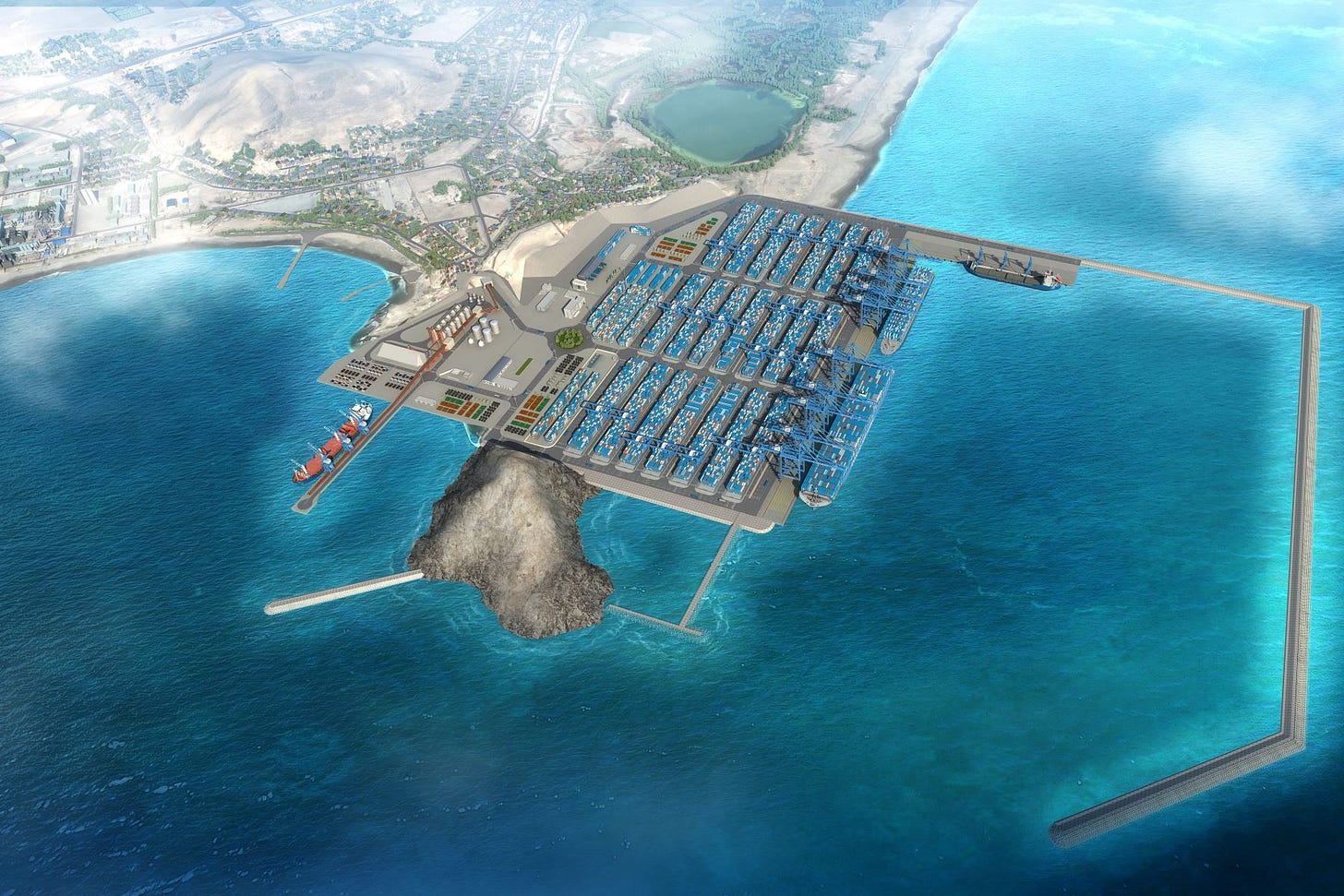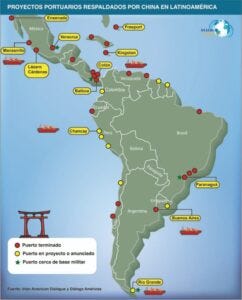Chancay Port: China's Grand Ambitions in Latin America
How China's Investment in Peru's Mega Infrastructure Project is Shaping Regional Trade and Relations
Over the past decade, the People's Republic Of China has been steadily investing in Latin America. As part of the Belt and Road Initiative (BRI), China has spent billions of dollars on mega infrastructure projects throughout the region. Peru is the textbook example of this, with the massive deep water port of Chancay. Back in 2008 the project was first proposed and by 2016 construction began (COSCO Puerto de Chancay, 2021). The Chancay Port is located approximately 70 km north of Lima, potentially becoming a massive economic hub not just for Peru, but for the entirety of South America. However, as the Peruvians are now realizing, some notable concessions are tied to this mega project. The Chinese can now exert immense influence in Peru and they have their own plans for the Chancay port.
(Photo Credit: COSCO Puerto de Chancay)
The Chancay port is one of the most important BRI projects in Latin America for the Chinese. The China Ocean Shipping Company (COSCO) is a state-owned Chinese firm that is responsible for the construction of the port. COSCO has a 60 percent stake in the port with the other 40 percent being owned by a local firm Volcan Compañía Minera (Sukhankin, 2024). The port is expected to cost over three billion dollars for COSCO with the company already having spent $1.3 billion on the first phase of construction (Stott, 2024). The port is expected to begin operations by the end of 2024, according to COSCO’s Public Affairs Manager, Mario de las Casas (The Maritime Executive, 2024). The Chancay port is made up of three major components; the first one is the port operational zone where port activities will be carried out. There are docks, storage areas, maintenance bays, and workshops. The second component is the entrance complex, which contains a customs inspection area, administrative offices, and logistics service areas. The last and most ambitious component is the underground tunnel that connects to the port. It is 1.8 km long and has three vehicle lanes for cargo transportation along with two conveyor belts for solid bulks and multiproduct pipes for liquid bulks. The Chinese have grand expectations for the port, with the Chinese ambassador to Peru perfectly summing it up “China is betting on Chancay to become the Shanghai of Peru” (Sukhankin, 2024). The port has a vast economic opportunity and can draw Peru even closer to the PRC economically.
Even before the construction of the Chancay port, China had invested greatly in Peru. In 2009, both countries signed a free trade agreement (Sukhankin, 2024) and now China has become Peru’s largest trading partner and investor. Peru is China’s second-largest supplier of copper ore and the exportation of iron ore accounted for over $1.4 billion in 2022 alone (Orbach, 2024). The Chinese have expanded into many strategic sectors of the Peruvian economy including telecommunications, energy infrastructure, mining, and construction. Through various state-owned firms, the PRC de facto controls the entire electric grid in Peru (Sukhankin, 2024). In 2013, the relationship between China and Peru was elevated to a comprehensive strategic partnership. Now with a more hostile government elected in Argentina, Peru is on track to become one of China’s most important strategic regional economic partners (Sukhankin, 2024). The Chancay Port is the ultimate embodiment of this strategic partnership. The port’s strategic significance goes far beyond its physical capabilities for container traffic.
The Chancay Port is a deep-water port with the capacity to process more than 18,000 containers and very large naval vessels (Narrea, 2022). Cargo will then be able to be moved across South America via the Pan-American highway. The increased trade volume from the Chancay Port will also boost trade volume in Peru’s other ports. The Chancay Port will transform Peru’s geopolitical standing beyond South America and the Asia-Pacific. Peru’s Foreign Minister, González-Olaechea identified some of the main benefits from the Chancay port. “First, our geostrategic location is recognized by the whole world and not only by the countries of the Asia Pacific. Second, trade to and from Chancay will lower transportation costs by streamlining navigation routes, thus benefiting everybody’s business” (Yeping, 2024). Peru will be able to export its resources, mainly minerals and agricultural products easier improving its overall macroeconomic stability. For China, the port would cut down shipping time by a third for Chinese-based producers greatly reducing costs (Andina, 2023). Peru will become an extremely important center for Chinese exports for the entirety of South America. Brazil, a BRICS member, has shown a keen interest in the Chancay port, as they would greatly benefit from easier access to Chinese markets. Brazil’s ambassador to Peru, Clemente Baena Suárez stated “The Brazilian side will be seeking prompt solutions to logistical, sanitary, and administrative obstacles in the border area near Peru to facilitate the travel of Brazilian trucks to Chancay in particular” (Sukhankin, 2024). The Chancay Port can also be a key component of the proposed Bioceanic Trade Corridor that can rival the Panama Canal.
(Peruvian Foreign Minister Javier González-Olaechea Franco Photo Credit: Peruvian Embassy in Beijing)
The Biocenaic Trade Corridor is a proposed network of highways, railways, and ports encompassing the width of South America. The route would stretch from southern Brazil across Paraguay and Argentina to ports in Chile and Peru. This vast infrastructure network would serve as an overland route to connect the Atlantic and Pacific oceans bypassing the Panama Canal. Many South American countries are supportive of this endeavor as it would not only decrease their shipping costs but it would also facilitate expansion into the global market increasing their geopolitical influnece. The Chinese have expressed great interest in this project and parts of it are incorporated into their BRI. Brazil’s ambassador to Peru said regarding the Chancay Port “[Brazilian companies] are happy that it will be possible to ship their goods to Asia without having to go through the Panama Canal” (Sukhankin, 2024). The recent disruptions to the Panama Canal due to drought (Tandon, 2024) have shown how vulnerable trade is in the Western Hemisphere and has further increased the desire to seek out alternatives. The Chancay Port will undoubtedly serve as a fundamental component for any future planned alternatives to the Panama Canal. However, the port is not without controversy.
Peru’s neighbor Chile, has expressed serious concerns regarding the port as they fear the Chancay port will redirect vital trade away from Chilen ports. Additionally, Chile is a massive exporter of copper and there are concerns that Peru now has an advantage in this sector as it will be easier for them to export to China. Additionally, the Chancay port may exacerbate the already dire illegal Chinese fishing situation. “Every year, nearly 600 Chinese fishing vessels fish illegally in and around Peru, Ecuador, and Argentina. The town of Chancay is a key fishing village, but local fishermen may be deprived of their livelihoods due to the presence of Chinese vessels” (Sukhankin, 2024). The port may also become an important part of the transnational drug trade. Cocaine in particular grown and processed in Peru and Bolivia can be smuggled out of this port to ports in Mexico to then be further smuggled into the United States.
(Photo Credit: Bloomberg)
The United States has also raised alarm bells over the growing influence of the Chinese in Latin America. General Laura Richardson, head of US Southern Command (SOUTHCOM) warned that China is “on the 20-yard line, in the red zone to our homeland” (Brar, 2023). Many analysts believe that these mega port projects that the Chinese are working on serve two purposes; one being the face value purpose of expanding Chinese trade in the region and the second less obvious purpose of expanding the PLA Navy’s influence and ability to deny access in the event of an armed conflict. The Shanghai Zhenhua Heavy Industries Company (ZPMC) has direct involvement in the construction and development of the cranes used in the Chancay port. ZPMC is closely linked to China’s civil-military cooperation strategy. Therefore with COSCO having a majority stake in the Chancay port alongside ZPMC working on the cranes that operate within the port, there is reason to believe that the Chinese military has some level of influence in how the port is operated. There are also concerns that due to the Chinese military’s access to the port, they will be able to collect maritime trade and logistics data from countries that use the port such as the United States and Australia leaving them vulnerable to cyber attacks (Sukhankin, 2024).
The Peruvians while supportive of this project raised some eyebrows at COSCO, when in March 2024, they attempted to remove COSCO’s exclusive right to operate the facility. This move was justified by the Peruvian National Port Authority (APN), which claimed it never had the legal authority to grant such exclusivity due to an "administrative error." The government sought to annul the original agreement, leading to significant tensions between COSCO and Peruvian officials. COSCO responded assertively to protect its investment and legal rights. The company emphasized that the original terms were crucial to its investment strategy and that any changes would severely impact the project's viability. The dispute reached a critical point when COSCO proposed a six-month negotiation period to resolve the issue amicably, warning of potential international arbitration if an agreement could not be reached. Arbitration, under the Chinese-Peruvian trade pact, would have significant financial and political implications for Peru. Losing COSCO's investment would deliver a substantial blow to the Peruvian economy. The job creation and infrastructure development the Chancay project would bring are far too valuable to put at risk. Additionally, Peruvian officials faced mounting pressure to change their position due to the potentially severe consequences of a diplomatic spat with China. China, a crucial trading partner and investor in Peru, could retaliate if relations soured. This economic pressure, specifically the threat of lost trade and investment, likely weighed heavily on Peruvian decision-makers. Furthermore, the looming possibility of a lengthy and costly arbitration process added another layer of urgency. The prospect of years of legal dispute, with an uncertain outcome, pushed Peruvian officials towards seeking a quicker and more favorable resolution to the dispute. It appears that the Peruvian government has backed down “Peru's legislature is considering a legal remedy to give Chancay back its exclusivity status” (Stott, 2024). This just goes to show the immense leverage the Chinese have over the Peruvians and how important the Chancay port is to China’s overall strategic ambitions for the region. The Chancay port in Peru is a key element in China's broader strategy of acquiring global ports, which aims to enhance China's influence over international trade routes and logistics networks. This strategy is integral to China's BRI, specifically its Maritime Silk Road component. The acquisition and development of ports like Chancay serve several strategic objectives for China.
Firstly, by developing and controlling ports in strategic locations worldwide, China ensures smoother and more efficient trade routes. This reduces transportation costs and enhances the reliability of Chinese exports and imports, strengthening its trade dominance. Secondly, ownership and operation of ports in various countries provide China with significant geopolitical leverage. It allows China to foster stronger economic ties with host countries, which can translate into political influence. In the case of Peru and other Latin American countries, this influence helps integrate these regions into the BRI framework, expanding China's sphere of influence. Thirdly, by controlling key nodes in global shipping routes, China can better secure its supply chains, ensuring that essential goods and raw materials are available even during global disruptions. Ports like Chancay offer a crucial link between Latin American resources and the Asian market. Additionally, developing foreign ports represents significant investment opportunities for Chinese companies, driving economic growth both domestically and abroad. The construction and operation of ports like Chancay create jobs and stimulate local economies, fostering goodwill and stronger bilateral relations.
(Map of Chinese Infrastructure Projects in Latin America Photo Credit: Dialogo Americas)
Although primarily commercial, these ports can potentially offer strategic military advantages, providing China with logistical support points for its navy and enhancing its global maritime reach. China’s overall strategy regarding port acquisitions includes several elements. The primary goal is network integration, aiming to integrate these ports into a cohesive network that supports the seamless movement of goods. This integration is not limited to Asia but extends to Africa, Europe, and the Americas, creating a global trade web centered around Chinese economic interests. Significant investments in port infrastructure improve the efficiency and capacity of these ports, making them critical hubs in global shipping. This infrastructure development often includes modernizing facilities, expanding capacity, and enhancing connectivity with inland transportation networks. Furthermore, China frequently enters into partnerships and joint ventures with local entities to facilitate port development. This approach not only helps overcome regulatory and political hurdles but also aligns local interests with China's strategic goals.
Ports like Chancay are part of broader economic corridors that link multiple regions through integrated transport and logistics networks. These corridors facilitate trade flow and economic integration, amplifying the impact of each port within the network. The Chancay port is thus a crucial part of China’s strategy to establish a comprehensive, globally integrated maritime network that supports its economic and geopolitical objectives. By controlling key maritime infrastructure, China strengthens its position as a dominant global trade player and secures its long-term strategic interests. The Chancay port serves as a prime example that China’s BRI infrastructure projects are created with strategic goals in mind and that in the end, the one who benefits the most is the PRC, even at the expense of their supposed partners such as Peru.
Refrences
Andina, A. (2023, December 28). From Chancay to Shanghai: A new silk road linking Asia and South America. ANDINA. https://andina.pe/ingles/noticia-from-chancay-to-shanghai-a-new-silk-road-linking-asia-and-south-america-968428.aspx
Brar, A. (2023, October 5). Peru's new port opens a door for China—and political influence in Latin America. Newsweek. https://www.newsweek.com/peru-china-us-port-political-influence-latin-america-belt-road-initiative-1832039
China (CHN) and Peru (PER) trade. The Observatory of Economic Complexity. (2024, March). https://oec.world/en/profile/bilateral-country/chn/partner/per
La República. (2022, September 13). Megapuerto de Chancay: ¿Cuál es su avance e importancia para el comercio entre Perú y China?. Últimas Noticias del Perú y el Mundo en larepublica.pe. https://larepublica.pe/sociedad/2022/09/09/megapuerto-de-chancay-cual-es-su-avance-inversion-e-importancia-para-el-comercio-entre-peru-y-china-mtc-puerto-del-callao
Mardones, I. (2022, November 15). Chinese investment in Peru set to reshuffle maritime trade in South America. Royal United Services Institute. https://www.rusi.org/explore-our-research/publications/commentary/chinese-investment-peru-set-reshuffle-maritime-trade-south-america
Tandon, A. (2024, May 1). Drought behind Panama Canal’s 2023 shipping disruption ‘unlikely’ without El Niño. Carbon Brief. https://www.carbonbrief.org/drought-behind-panama-canals-2023-shipping-disruption-unlikely-without-el-nino/
THE MARITIME EXECUTIVE, A. (2024, April 3). Peruvian regulator upsets Cosco with ruling on Chancay Port. The Maritime Executive. https://maritime-executive.com/article/peruvian-regulator-upsets-cosco-with-ruling-on-chancay-port
Narrea , O. (2022, October). Sharing Chinese and Peruvian Visions about the Future Chancay Port: Exploring Opportunities under the Belt and Road. Center for China and Asia-Pacific Studies Universidad del Pacífico . https://cechap.up.edu.pe/wp-content/uploads/Working-Paper-Nro3-Omar-Narrea.pdf
Orbach, J. (2024, February 15). Explainer: China’s free-trade agreements in Latin America. AS/COA. https://www.as-coa.org/articles/explainer-chinas-free-trade-agreements-latin-america#:~:text=Trade%20between%20Peru%20and%20China,Beijing%20upping%20its%20minerals%20intake.
The project – COSCO puerto de chancay / terminal Portuario Multripropósito. COSCO PUERTO DE CHANCAY TERMINAL PORTUARIO MULTRIPROPSITO. (2021). https://coscochancay.pe/en/the-project/
Ripoll, V. F., & Cortés, H. (2023, November 7). Bi-oceanic corridor – a transportation artery across Latin America. MAPFRE Global Risks. https://www.mapfreglobalrisks.com/en/risks-insurance-management/article/bi-oceanic-corridor-a-transportation-artery-across-latin-america/
Stott, M. (2024, March 26). China megaport builder hits back as Peru moves to scrap exclusivity deal. Financial Times. https://www.ft.com/content/58bc4e62-c42f-4121-bba3-4607ab53a78e
Sukhankin, S. (2024, March 15). “from Chancay to Shanghai”: Peru’s strategic role in PRC maritime strategy. Jamestown. https://jamestown.org/program/from-chancay-to-shanghai-perus-strategic-role-in-prc-maritime-strategy/
Yeping, Y. (2024, May 15). Peru, China forging robust economic ties, with vast potential for cooperation: Peruvian foreign minister. Global Times. https://www.globaltimes.cn/page/202405/1312299.shtml









